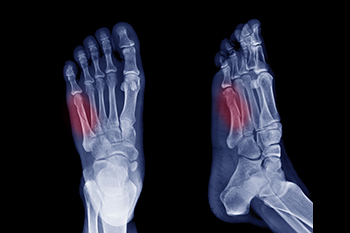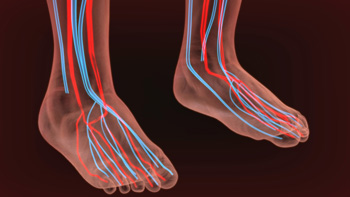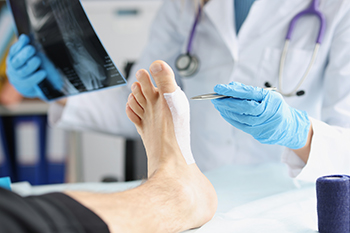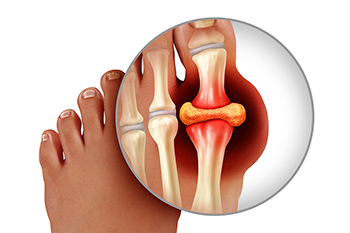January 2025
Do Your Child's Feet Hurt?
Jones Fracture Symptoms

A Jones fracture refers to a break or crack in the fifth metatarsal bone, located on the outer side of the foot near the ankle. Symptoms typically include pain, swelling, bruising, tenderness on the outer part of the foot, and difficulty walking. Diagnosis usually involves a visit to a podiatrist, who will perform a physical examination, review the symptoms, and take a detailed medical history. To confirm the fracture, imaging tests like X-rays are commonly used. Treatment options depend on the severity of the fracture. For minor cases, rest, mild pain relievers, and possibly a cast or splint may be recommended. Crutches could also be necessary to help avoid putting weight on the affected foot. In more severe cases, surgery may be required to properly heal the bone. Full recovery can take several months, so it is important to allow enough time for the bone to heal completely to prevent further injury. If you suspect you have a Jones fracture, it is suggested that you consult a podiatrist for an accurate diagnosis and personalized treatment plan.
A broken foot requires immediate medical attention and treatment. If you need your feet checked, contact John McGhan, DPM from Gold Canyon Foot & Ankle. Our doctor can provide the care you need to keep you pain-free and on your feet.
Broken Foot Causes, Symptoms, and Treatment
A broken foot is caused by one of the bones in the foot typically breaking when bended, crushed, or stretched beyond its natural capabilities. Usually the location of the fracture indicates how the break occurred, whether it was through an object, fall, or any other type of injury.
Common Symptoms of Broken Feet:
- Bruising
- Pain
- Redness
- Swelling
- Blue in color
- Numbness
- Cold
- Misshapen
- Cuts
- Deformities
Those that suspect they have a broken foot shoot seek urgent medical attention where a medical professional could diagnose the severity.
Treatment for broken bones varies depending on the cause, severity and location. Some will require the use of splints, casts or crutches while others could even involve surgery to repair the broken bones. Personal care includes the use of ice and keeping the foot stabilized and elevated.
If you have any questions please feel free to contact our office located in Gold Canyon, AZ . We offer the newest diagnostic and treatment technologies for all your foot and ankle needs.
Circulation Problems and the Feet

Circulation problems in the feet occur when blood flow to the feet, toes, or ankles is restricted due to narrowed arteries. Poor circulation is often the result of atherosclerosis, where plaque builds up in the blood vessels. A result of poor circulation is peripheral arterial disease, or PAD. Patients with PAD may experience symptoms like numbness, tingling, burning sensations, or cramping in the feet or lower legs during activity. Additional signs include cool, pale skin, hair loss on the feet, slow-healing sores, and a diminished pulse. People with diabetes, high cholesterol, high blood pressure, or a history of smoking are at increased risk of developing PAD. A podiatrist can assess your circulation issues through non-invasive tests, such as the ankle-brachial index, or ABI, or a Doppler ultrasound to determine blood flow and identify any blockages. Timely diagnosis and treatment by a podiatrist can help reduce symptoms and prevent complications, like non-healing foot wounds or infections. If you have circulation problems in the feet, it is suggested that you schedule an appointment with a podiatrist for an exam and treatment.
Poor circulation is a serious condition and needs immediate medical attention. If you have any concerns with poor circulation in your feet contact John McGhan, DPM of Gold Canyon Foot & Ankle. Our doctor will treat your foot and ankle needs.
Poor Circulation in the Feet
Poor blood circulation in the feet and legs is can be caused by peripheral artery disease (PAD), which is the result of a buildup of plaque in the arteries.
Plaque buildup or atherosclerosis results from excess calcium and cholesterol in the bloodstream. This can restrict the amount of blood which can flow through the arteries. Poor blood circulation in the feet and legs are sometimes caused by inflammation in the blood vessels, known as vasculitis.
Causes
Lack of oxygen and oxygen from poor blood circulation restricts muscle growth and development. It can also cause:
- Muscle pain, stiffness, or weakness
- Numbness or cramping in the legs
- Skin discoloration
- Slower nail & hair growth
- Erectile dysfunction
Those who have diabetes or smoke are at greatest risk for poor circulation, as are those who are over 50. If you have poor circulation in the feet and legs it may be caused by PAD and is important to make changes to your lifestyle in order to reduce risk of getting a heart attack or stroke. Exercise and maintaining a healthy lifestyle will dramatically improve conditions.
As always, see a podiatrist as he or she will assist in finding a regimen that suits you. A podiatrist can also prescribe you any needed medication.
If you have any questions please feel free to contact our office located in Gold Canyon, AZ . We offer the newest diagnostic and treatment technologies for all your foot and ankle needs.
Common Types of Foot Surgery

Foot pain can often be attributed to conditions that require surgical intervention, such as bunions, hammertoe, metatarsalgia, and neuromas. Bunions are painful bony bumps on the side of the foot, caused by misalignment of the toe joint. Hammertoe, where the toe bends abnormally, results from muscle imbalances, often worsened by tight shoes. Metatarsalgia refers to pain in the ball of the foot, usually from overuse or from wearing improper footwear, while a neuroma is a thickening of tissue surrounding nerves in the foot, causing sharp, burning pain. In addition to pain, symptoms for these conditions include swelling, deformity, and difficulty in hwalking. Conservative treatments like footwear changes, orthotics, or targeted exercises can help, but surgery may be needed in severe cases. Surgical options vary, from joint realignment to nerve decompression, depending on the condition. A podiatrist can evaluate your symptoms and recommend the most appropriate surgical or non-surgical treatment for relief. If you have any foot problem, it is suggested that you schedule an appointment with a podiatrist.
Foot surgery is sometimes necessary to treat a foot ailment. To learn more, contact John McGhan, DPM of Gold Canyon Foot & Ankle. Our doctor will assist you with all of your foot and ankle needs.
When Is Surgery Necessary?
Foot and ankle surgery is generally reserved for cases in which less invasive, conservative procedures have failed to alleviate the problem. Some of the cases in which surgery may be necessary include:
- Removing foot deformities like bunions and bone spurs
- Severe arthritis that has caused bone issues
- Cosmetic reconstruction
What Types of Surgery Are There?
The type of surgery you receive will depend on the nature of the problem you have. Some of the possible surgeries include:
- Bunionectomy for painful bunions
- Surgical fusion for realignment of bones
- Neuropathy decompression surgery to treat nerve damage
Benefits of Surgery
Although surgery is usually a last resort, it can provide more complete pain relief compared to non-surgical methods and may allow you to finally resume full activity.
Surgical techniques have also become increasingly sophisticated. Techniques like endoscopic surgery allow for smaller incisions and faster recovery times.
If you have any questions please feel free to contact our office located in Gold Canyon, AZ . We offer the newest diagnostic and treatment technologies for all your foot and ankle needs.
Preventing Gout Flare-Ups

Gout is a form of arthritis caused by the buildup of uric acid crystals in the joints, leading to sudden, intense pain, redness, and swelling, often in the big toe. The primary cause of gout is high levels of uric acid in the blood, which can result from certain foods, alcohol, or dehydration. To avoid flare-ups, it is important to limit foods that increase uric acid levels, such as red meat, shellfish, organ meats, sugary drinks, and alcohol, especially beer. Instead, focus on eating more fruits, vegetables, and whole grains, and drink plenty of water to help flush uric acid from the body. A podiatrist can help manage gout by diagnosing flare-ups, providing anti-inflammatory treatments, and recommending lifestyle changes, including dietary adjustments. In some cases, this type of doctor may prescribe medications to lower uric acid levels or prevent future attacks. If you have gout, it is suggested that you are under the care of a podiatrist who can help you to manage this painful condition.
Gout is a foot condition that requires certain treatment and care. If you are seeking treatment, contact John McGhan, DPM from Gold Canyon Foot & Ankle. Our doctor will treat your foot and ankle needs.
What Is Gout?
Gout is a type of arthritis caused by a buildup of uric acid in the bloodstream. It often develops in the foot, especially the big toe area, although it can manifest in other parts of the body as well. Gout can make walking and standing very painful and is especially common in diabetics and the obese.
People typically get gout because of a poor diet. Genetic predisposition is also a factor. The children of parents who have had gout frequently have a chance of developing it themselves.
Gout can easily be identified by redness and inflammation of the big toe and the surrounding areas of the foot. Other symptoms include extreme fatigue, joint pain, and running high fevers. Sometimes corticosteroid drugs can be prescribed to treat gout, but the best way to combat this disease is to get more exercise and eat a better diet.
If you have any questions please feel free to contact our office located in Gold Canyon, AZ . We offer the newest diagnostic and treatment technologies for all your foot and ankle needs.


